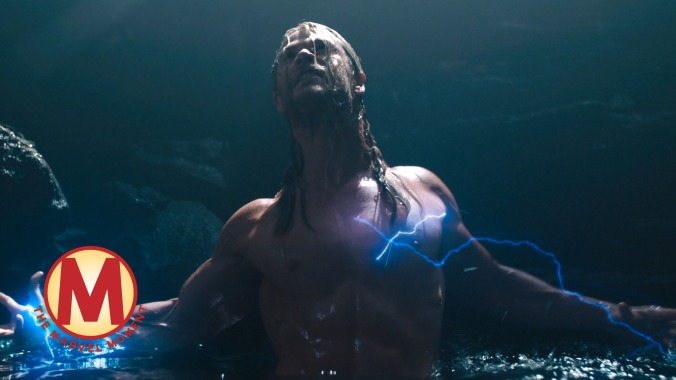Avengers: Age Of Ultron (and Thor's weird cave bath) showed us a studio's growing pains


“Really, really unpleasant.” That’s Joss Whedon discussing his chats with the suits behind Avengers: Age Of Ultron, a movie that’s not a failure so much as a two-and-a-half-hour growing pain. Did the studio ever think they’d make it this far? That the connective tissue would pile high enough that its films would begin doubling as story and central axis from which to launch future stories? Ultron is a living document of a studio learning how to sustainably grow a franchise that’s more than just a series of sequels, as well as a filmmaker struggling to balance the needs of his story with that of the brand.
That’s not to say Ultron is a dud. Its tale of AI gone wild is blessed by Whedon’s giddy, winking blend of action and personality, even if it’s not as present as it was in his first go at the tentpole. But the gang trying (and failing) to wield Thor’s hammer is a charming, character-driven dose of humanity in a cartoon world, while the surprising reveal that Hawkeye is a Midwestern dad with a life outside S.H.I.E.L.D. serves as a soul-warming stabilizer in a maelstrom of hifalutin lore. These, however, are only blips in an otherwise overstuffed film, one with too many characters, too many action sequences, and too much sentimentality, the likes of which—Black Widow and Bruce Banner’s budding romance, specifically—Whedon just doesn’t have the space to lace with pathos.
There’s perhaps no greater illustration of the film’s issues, though, than Thor ditching his pals to take a dip in some nondescript cave pond, one that apparently helps him understand the infinity stone lodged in Vision’s forehead. Or something? Viewers wrinkled their foreheads at the scene in theaters and Whedon eventually revealed that what was shown was just one piece of a much larger sequence. He was also candid about how, over time, test screenings, studio interference, and ultimatums found the scene sliced, diced, excised, and eventually reinserted in its opaque final form. He’s said that keeping it was better than simply explaining what happened—here’s a primer—but the cave scene serves not only to kill the pacing but also to further confuse what’s already a labyrinthian narrative. As such, the infinity stones remained inscrutable, a featureless MacGuffin.
Consider also, though, that Tom Hiddleston’s Loki was initially meant to appear in the sequence, but was excised because audiences couldn’t grasp him as anything but a villain. “[I]n test screenings, audiences had overemphasized Loki’s role,” Hiddleston explained, “so they thought that because I was in it, I was controlling Ultron, and it was actually imbalancing people’s expectations. So Joss and Kevin were like, ‘Let’s cut it, because it’s confusing people.’” The studio was still learning how to make these films, yes, but the audience was learning how to watch them. Can you imagine those same people encountering something so sprawling as Infinity War?
Ultron is a mess, but the good news is that everyone seems to have learned from it. With Civil War and Infinity War, Joe and Anthony Russo have proven themselves to be efficient puzzle-assemblers, having coherently paired story beats with teasers and fan service. That could change, though. Endgame’s set to be the franchise’s most ambitious offering yet, with arcs to conclude, superheroes to resurrect, characters to fold in, and series to tease. They’re gonna need every second of those three-plus hours.
GET A.V.CLUB RIGHT IN YOUR INBOX
Pop culture obsessives writing for the pop culture obsessed.